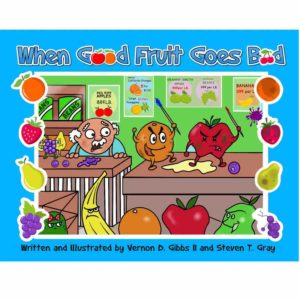
This whimsical book will teach your children about minimizing food waste through delicious solutions to overripe fruit!
By Vernon D. Gibbs and Steven T. Gray
What is Good Fruit Goes Bad About
When Good Fruit Goes Bad tells the story of Hank Huckleberry, a man who sells fruit. One day when Hank goes to work, he is greeted by a less than fruity scene: fruit that has gone bad, literally! Dented apples are fighting with bruised oranges, while angry avocadoes and bitter grapefruits sit in sour defiance of their near ending. The grapes quiver in fear they will be turned into grape juice, while the soft watermelons bully the tiny cherries. The fruit explains they are tired of being tossed if they are not perfect. Hank Huckleberry calls upon his friend Sarah Sweets to help save his store, who explains that ‘bad’ fruit can still be good! These sweet fruits are full of fiber and vitamins. Splotchy avocado can become creamy guacamole, speckled bananas make sweet banana bread, and mushy berries transform into tangy jams.
Gibbs and Gray’s colorful tale introduces children to the concept of food waste and ways to prevent throwing away perfectly good fruit that may not look perfect! This story also opens up the conversation to discuss different types of fruits and creative ways to eat them. This can be wonderful for children who are picky eaters yet may be open to tasting a peach scone or raspberry jam.
After reading Good Fruit Goes Bad, try some of these activities:
- Search through your fridge or fruit bowl with your child, scouting out ripe bananas, peaches, or berries. Make banana bread, peach cobbler, or jam together!
- Discuss other ways to avoid unnecessary waste in your kitchen! Perhaps begin a compost bin, or save up vegetable scraps for soups.
- Together, add up the cost of any wasted or expired food in your fridge, freezer, or pantry and discuss what that money could have purchased.
- Subscribe to an ugly produce or imperfect produce subscription. Your kids may discover that a two-headed strawberry is just as tasty as the original.
- Consider setting up a subscription to a Community Supported Agriculture (CSA) box to help reduce food waste and buy locally and seasonally.
- Take these 10 steps as a family to reduce food waste and visit our taste a rainbow of colors toolkit to boost fruit and veggies in your family’s diet.












